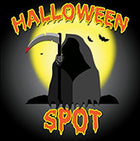Why Do People Dress Up For Halloween?
Posted by Ambir Jarvis on

Every year, people all around the world celebrate Halloween. Whether people choose to take their kids trick-or-treating or rock a flower power costume to a themed party, Halloween is a mysterious holiday with a rich background. But why do people actually dress up for Halloween? This article is going to delve into the history of Halloween and how it became what it is today.
Halloween is thought to date back to around 800 B.C. when the Celts and Gauls ruled parts of Great Britain and Northern France. On the Celtic calendar, October 31 marks the last day of the year, meaning it was a day of celebration before winter. This celebration brought the death of life, nature, and the harvest.
Gaelic people believed it was important to honor the dead at the end of the year. The holiday was called Samhain, which means "summer's end" in Old Irish.
Because this was a day to both honor spirits and ward off the unwanted spirits, it makes sense that today's Halloween celebrations feature a lot of scary costumes for women and men. Many people back then chose to wear scary costumes to not only honor the tradition but to also scare away evil spirits. Furthermore, in hopes of appeasing the haunted spirits, people would dress up in ghost costumes if they left their homes in an attempt to blend in with the spirits.
"Guising" became another tradition, which consisted of young people dressing up and performing at people's doors in exchange for money or food.
After the Romans invaded France and Britain during the 1st century B.C., their festival traditions mixed in with those of Samhain. Both the festival of Pomona and All Saints' Day are were celebrated on or around November 1. The festival of Pomona celebrated the apple harvest while All Saints' Day honors saints and the recently deceased.
These traditions became a time to ward off spirits and honor the dead throughout European countries. Extra candles were bought, graveyards were visited, and prayers were sent to saints.
However, immigrants from Ireland and Scotland were the ones who truly brought Halloween to the United States during the 1800s. With them, they brought their mix of Pomona, Samhain, and pagan traditions.
Halloween didn't become largely commercialized in America until the 1950s, hence the popularity of 1950s Halloween costumes.
All around the world, Halloween is celebrated differently. But in the United States, the tradition has become less about warding off evil spirits and more about dressing up and going trick-or-treating. Although with its background, scary costumes for women and men, as well as scary Halloween costumes for tweens and the classic teen devil costume remain popular choices every year.
So whether you choose to stay home and light some candles to protect yourself from evil spirits or look into scary costumes for women or men to wear to a party, keep in mind the tradition of Halloween this year.



